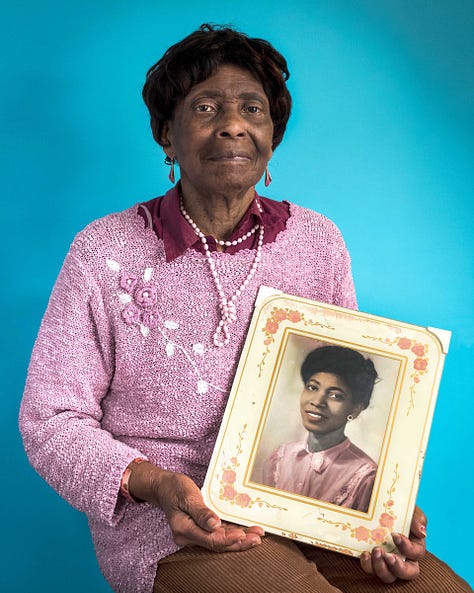Tomorrow is the official Renters’ Day of Action. Organised by the Renters Reform Coalition, the idea is to create “one of the largest coordinated political actions taken by private renters in UK history” and pressure the Government to end the renting crisis and bring forward the Renters Reform Bill.
So, in today’s issue, we’re taking a look at just what’s going on with London’s housing and property situation, plus we've got details of a new exhibition from one of our favourite documentary photographers.
This issue is public so, if you enjoy it, then please feel free to share it wherever you like:
Something’s rotten in the estates of London

The hope was that London’s rental market would ‘stabilise’ in 2023, as more properties became available and landlords reduced prices to match what is euphemistically termed the “effective cap on tenants’ budgets” caused by “affordability pressures”.
As it stands, the London rental market is about as stable as Hammersmith Bridge.
Last week the real estate company JLL forecast that there would be a shortfall of more than 110,000 rental homes in London by 2030. In that same period the city’s population is expected to rise by 700,000. Numbers which prompted The Telegraph to declare that London is currently “hurtling towards a third phase of the pandemic fallout”.
According to Zoopla, rental demand in London last month was 44% higher than the five-year average, while supply was down by 41%.
The other thing that was supposed to happen this year was a fall in house prices. If that happened it would encourage more people to swap renting for buying and help ease this “supply black hole”.
But, right now, house prices in London are around 13 times the average household income (the international standard is three times), a stat which prompted one economist to call London and the South-East “not just unaffordable [but] extravagantly unaffordable,” and the chief operating officer of UK Regeneration to say that “the London housing market is rotten and every aspect of it needs rebuilding”.
Last week, two equally depressing studies came out; one showing that homeowners in London are £3,000 a year better off than renters; and the other showing that “all but the highest earners” are being forced to the outer boroughs and commuter towns.
You would have expected the Tories to use last week’s Budget to start targeting all those disenfranchised Londoners ahead of next year’s (likely) general election; but there was pretty much nothing in Jeremy’s little red box for renters or mortgage payers.
Nobody was realistcally expecting a rent freeze, but there was nothing for first-time buyers, nothing to encourage new landlords, nothing that might increase housing stock, and not even any incentives for people to make their homes more energy efficient and cheaper to heat.
The Centre for London’s response to the Budget pretty much summed it up:
“The Budget has offered precious little to the thousands of households in the capital unable to afford the cost of their homes and rents. Without recognition of the housing crisis, we will see key workers driven out of London by soaring costs.”
Key underperformance indicators
There’s a lot more going on under the surface of London’s housing situation, as demonstrated by these three articles which all came out last week:
Last Wednesdsay the FT published this incredible (unpaywalled) investigation into the state of properties owned by the housing association Peabody’s. The paper spoke to 35 Peabody residents across London and found “widespread mismanagement of homes” including evidence of “neglect, mould, chronic disrepairs, as well as rising service charge bills and a culture of poor communication which makes resolving issues a maddening task.”
The next day The Guardian ran this piece on the “nefarious” trend of landlords “hiking rent in response to requests for maintenance or even necessary repairs” from tenants who are having to live with issues like mould, damp and flooding for fear of being ’effectively evicted’.
And on the same day, it was reported that “a multimillion-dollar apartment” in Kensington, is officially owned by the “8-year-old daughter of Vladimir Putin ally” and “grocery tycoon” Vladimir Gruzdev.
Coming up on Wednesday 🔮
In our subscriber-only edition this week, we’re going back to check on the accuracy of our predictions from the end of last year.
Subscribe to LiB now and that will be in your inbox first thing on Wednesday.
Precious legacies
Almost a year ago we ran an interview with the documentary photographer Jim Grover about his brilliant exhibition, Behind the Shop Facade.
That exhibition told the life story of Maurice ‘Murray’ Dorfman, a Clapham shopkeeper who had run the haberdashery and dressmakers, Jeannette Fashions, which stood at 20-22 Clapham High Street for over sixty years. It was one of our favourite exhibitions of the whole year.
During our conversation with Jim, he talked about a previous exhibition he’d put on in 2018 at the Oxo Gallery, to celebrate the 70th anniversary of the arrival of SS Windrush.






As he told The Guardian at the time, Windrush: Portrait of a Generation began after a parishioner at his local church invited him to see the clubs where he played dominoes. That led to Jim taking portraits in domino clubhouses in Clapham, Croydon and Wandsworth, and then in community centres, places of worship and even funerals across South London.
As 2023 marks the 75th anniversary of the arrival of SS Windrush, Jim is hoping to put on a brand-new exhibition to celebrate what the Windrush generation, “have contributed to this country, and their invaluable legacy” as well as “how the 2nd and 3rd generations are taking the legacy forwards.”
Jim has been busy taking new photographs and conducting new interviews and has already secured Clapham Library as a venue for the exhibition (where Behind the Shop Facade was displayed).
The plan is to run the new exhibition from June to August - as Windrush Day is on June 22nd - but to do that he needs to raise £16,000 to cover the ‘out-of-pocket costs’ of creating and staging the exhibition (which will be free to access).
Jim has started a Kickstarter to raise £10,000 (he’s covering the other £6,000 out of his own pocket) and, as we write this, he is very close to that ten grand target. If we could help push him over the line that would be amazing (and to get him even closer that £16k would be even better).
5 little bits
The BBC reports on the rising number of ‘high-value watch’ thefts in London and the petition launched by Andrew Dinsmore, the Conservative member of Hammersmith and Fulham Council, to ban the sale of machetes (Dinsmore was robbed for his watch last year by a man holding an 18-inch machete).
Isaac Rangaswami, the man behind the @caffs_not_cafes Instagram account, has written an editorial for The Guardian about his love of “laminate-clad safe havens” and why these “cultural treasures” shouldn’t be allowed to disappear.
If you’re an O2 or Virgin customer you can now get “high-speed mobile connectivity” on the Central line between Holland Park and Queensway, and the Northern line between Archway and Kentish Town. The plan is to have the rest of the network connected up by the end of 2024.
The National Theatre revival of The Crucible, starring Erin ‘Princess Anne’ Doherty is transferring to the Gielgud Theatre in June, where the role of Abigail will be taken on by Milly House of the Dragon Alcock in her West End debut.
In film and TV news: Some repugnant and invasive specimens have been spotted near Shoreditch Boxpark… There’s also a new Last of Us exhibit in the area.
 BREAKING NEWS - A Cordyceps outbreak has hit London and already infected a gamer. Reports indicate they were a fungi. Experts link this outbreak to the increase in players experiencing The Last of Us on PS5. #LiveFromPS5
BREAKING NEWS - A Cordyceps outbreak has hit London and already infected a gamer. Reports indicate they were a fungi. Experts link this outbreak to the increase in players experiencing The Last of Us on PS5. #LiveFromPS5


While, below, Idris Elba goes on a cab tour of his “favourite London spots” for Netflix and, in the NY Times (you might need to login), the leads from Rye Lane, David Jonsson and Vivian Oparah, talk about how the film celebrates “two lively London neighborhoods that are changing fast”.





